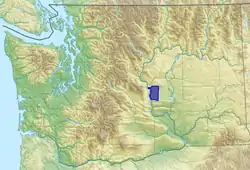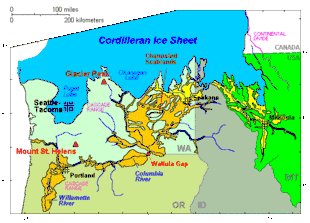Ancient Lakes of the Columbia Valley AVA
The Ancient Lakes of the Columbia Valley AVA (referred to locally as the Ancient Lakes AVA) is an American Viticulture Area which lies on the western edge of the Columbia Basin near the town of Quincy in Washington state. The wine region is entirely included within the larger Columbia Valley AVA. Ancient Lakes of the Columbia Valley became the 13th AVA in Washington State on October 18, 2012.[1]
| Wine region | |
 | |
| Official name | Ancient Lakes of the Columbia Valley |
|---|---|
| Type | American Viticulture Area |
| Year established | October 2012[1] |
| Country | United States |
| Part of | Columbia Valley AVA, Washington |
| Growing season | 182 days |
| Precipitation (annual average) | < 8" year |
| Soil conditions | Quincy loam and windblown loess soils |
| Total area | 162,762 acres[1] |
| Size of planted vineyards | Approx 1800 acres[2] |
| Grapes produced | Primary Grapes Produced: Riesling, Pinot Gris, Chardonnay, Syrah, Merlot[3] |
Geography

Lying between the Beezley Hills to the North and the Frenchman Hills to the south, the growing region was severely impacted by the immense water flows of the Missoula floods. The scouring effect of the waters stripped the top soils down to the basalt and scoured out canyons referred to locally as "coulees" which are prominent features near many of the planted vineyards.[4] The Columbia River forms the western border of the grape growing region.
Soils
Basalt and caliche rock are unique in their prominence of the soils in the grape growing areas. Missoula floods scoured the area stripping the original top soils along the western edge of the Quincy valley. Large standing pools of water left by the floods created thick deposits of caliche that lay over the basalt. With time, both rock types have fractured and are prominent in the soils. Quincy loam and windblown loess soils lay over the rocks.
Climate
The growing region lies close to the easternmost foothills of the Cascade Mountain range. A strong rain shadow effect gives the area one of the lowest precipitation rates[5] in the Columbia Valley.

Grape growing
Deep in the heart of Washington Wine country, white wine grapes represent the bulk of the grape plantings in the growing region and are planted on the higher elevations (avg. 1200–1500') along the Beezley Hills and the Evergreen and Babcock ridges.
White Riesling, Chardonnay, and Pinot Gris are dominant plantings along with red varieties used for rosé-style wines
Red wine varieties are planted in close proximity to the Columbia River along the benches and exposed basalt cliffs formed by the "cataract effects" of the Missoula floods. This area lies at a lower elevation and is considerably warmer, lending itself to red wine grape production including Syrah, Merlot and others.
Vineyards
- Cave B- Familigia Vineyards
- Jones of Washington
- Evergreen Vineyards
- Ryan Patrick Vineyards
- Spanish Castle Vineyards
- White Heron Cellars
References
- "Establishment of the Ancient Lakes of Columbia Valley Viticultural Area" (27 CFR 9 77 FR 64033). Federal Register. Alcohol and Tobacco Tax and Trade Bureau. October 18, 2012. pp. 64033–64036. Retrieved February 4, 2016.
- "Ancient Lakes of Columbia Valley". Washington State Wine. 2014. Archived from the original on March 14, 2015. Retrieved January 4, 2017.
- "Ancient Lakes of Columbia Valley Wine". Wine-Searcher. April 28, 2014. Retrieved May 24, 2020.
- Bjornstad, Bruce N. (May 1, 2006). On the Trail of the Ice Age Floods: A Geological Field Guide to the Mid-Columbia Basin. Sandpoint, Idaho: Keokee Books. p. 2. ISBN 978-1-879628-27-4.
- "Climate Quincy – Washington". US Climate Data. Retrieved February 4, 2016.